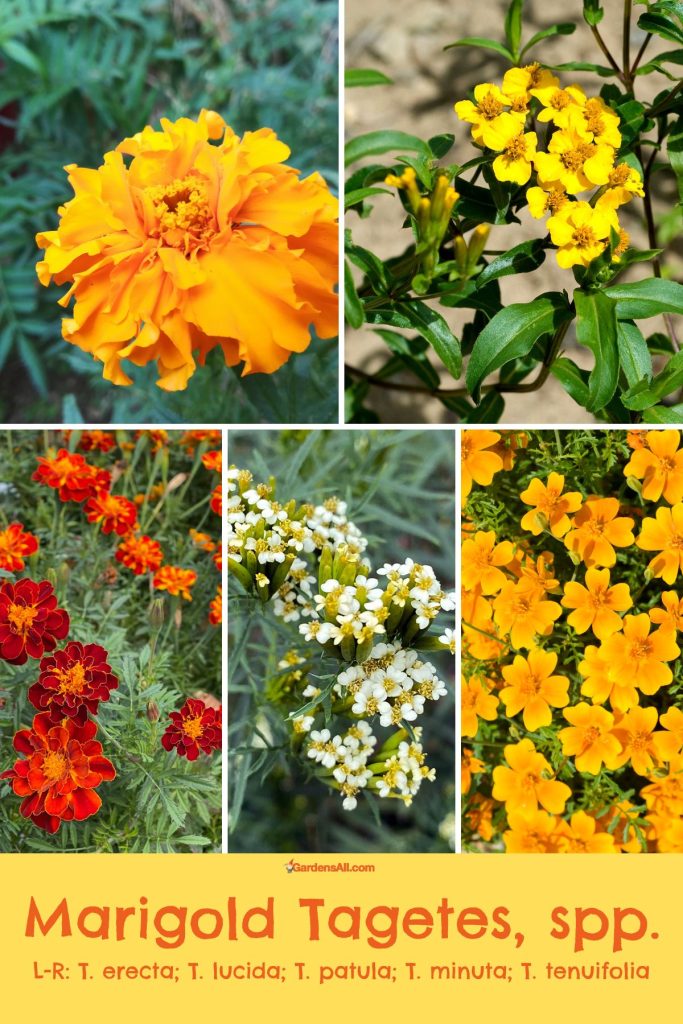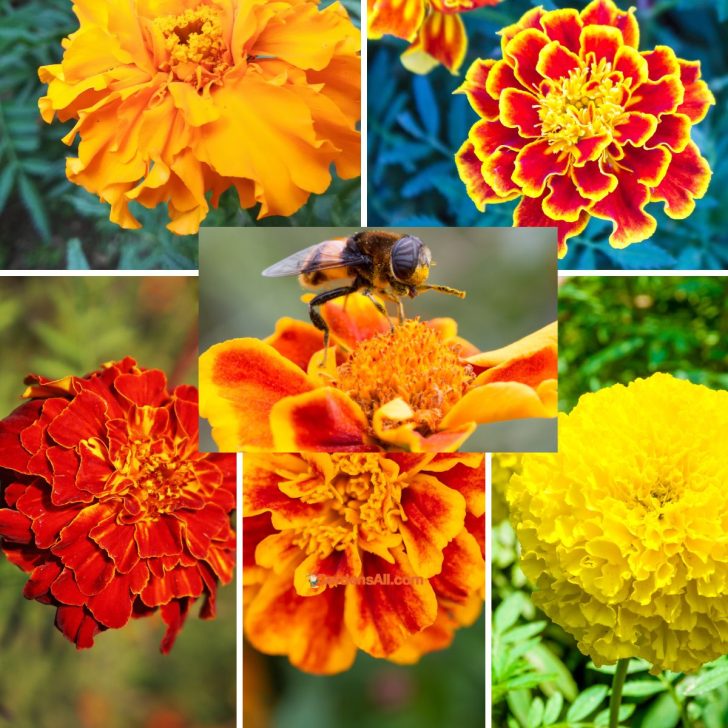Also known as the True Marigold, the Tagetes Marigold benefits and uses is a HUGE topic because this plants offers an abundance of that!
There are many wonderful uses of Marigold Tagetes species, from ornamental to garden pest control, culinary and medicinal, the Tagetes species of Marigolds contain as many hidden treasures as they do visible ones!
Any search online for uses of marigold will bring up mostly results related to Calendula officinalis, (see Calendula benefits). However, Calendula, often called by the common name of “pot marigold”, is actually a different plant genus and is not considered a “true Marigold”.
So this article is specifically about the true marigold plant, of the Tagetes genus, (pronounced Tă-jŭh-teez), native to America and now widely cultivated and popular globally.
Tagetes spp. Marigold Scientific Name
- GENUS: Tagetes
- FAMILY: asteraceae
Tagetes is the genus name for this plant in the Asteraceae family, which is one of the largest plant families in the world.
Asteraceae numbers over 23,000 members and include mums and daisies, as well as wild flowers like daisy fleabane and Calico asters, sunflowers and sunchokes, and a number of plants, shrubs and trees.[1]https://www.britannica.com/plant/Asteraceae
Marigold Tagetes Taxonomy
- Kingdom: Plantae
- Domain: Eukarya
- Phylum: Tracheophyta
- Class: Magnoliopsida
- Order: Asterales
- Family: Asteraceae
- Genus: Tagetes
- Family: Asteraceae
- Order: Asterales
- Class: Magnoliopsida
- Phylum: Tracheophyta
- Domain: Eukarya
You can find more on the Marigold history here.
Uses of Marigold Tagetes spp.
Studies prove that several species of Tagetes contain pesticidal activity. However, some are proven, others are valid lore, some maybe myths. So we’ve created comprehensive lists on all that we’ve found and included scientific validation where available.
All marigolds have similar properties, however some of the most studied Tagetes are on the African marigold (Tagetes erecta), Mexican Marigold, (T. minuta), and French marigold, (T. patula).
If you know of other proven or traditional uses, or your own direct experience of marigold Tagetes, we’d love to hear from you.
Meanwhile, here’s are our lists compiled to date on most of the uses of marigold Tagetes, broken down by type of usage.
Garden, and Landscape Uses of Marigold Tagetes
- Attract beneficial insects
- Aromatic and attractive brightly flowered bedding plant in landscapes
- Companion plants in the garden help deter pests and disease
- Cover crop
- Can reduce growth in troublesome weeds, including:
- Pest repellent, deterrent
- deer
- rabbits
- insects
- Insects / insecticidal
- Nematode suppression, especially the root knot nematodes (Meloidogyne spp.), [2]https://edis.ifas.ufl.edu/publication/NG045
See also, our article on Marigold as Insecticidal
- Nematode suppression, especially the root knot nematodes (Meloidogyne spp.), [2]https://edis.ifas.ufl.edu/publication/NG045
- Plant Diseases:
- Bactericidal – Fungus / Fungicidal – T. minuta essential oil showed inhibition against Aspergillus niger[3]https://pubmed.ncbi.nlm.nih.gov/31724710/
- Viruses – some plant viruses have been found to be remediated by some Tagetes compounds.
Consider planting marigolds and other deer resistant flowers around plants that deer love, such as hostas or okra plants, to help repel deer from eating them.
Insecticidal Uses of Marigold Tagetes
An extensive study on the the French marigold (Tagetes patula), identified the ability to repel numerous of the hemiptera “true bugs”:
- aphids [4]https://pdfs.semanticscholar.org/a21e/eba9c5719d37f9aff99b8f8aa2b206d826d9.pdf
- bed bug [5]https://www.ncbi.nlm.nih.gov/pmc/articles/PMC7237031/#pone.0233511.ref029
- caterpillars[6]https://www.ncbi.nlm.nih.gov/pmc/articles/PMC7237031/#pone.0233511.ref031
- grain/seed beetles[7]https://pubmed.ncbi.nlm.nih.gov/23778081/
- leaf hopper[8]https://www.ncbi.nlm.nih.gov/pmc/articles/PMC7237031/#pone.0233511.ref022
- lice[9]https://www.ncbi.nlm.nih.gov/pmc/articles/PMC7237031/#pone.0233511.ref028
- mites, (nematicides)[10]https://www.ncbi.nlm.nih.gov/pmc/articles/PMC7237031/#pone.0233511.ref034
- mosquitoes / mosquito larvae – T. erecta (African), T. minuta (Mexican), T. patula (French)[11]https://agris.fao.org/agris-search/search.do?recordID=US201302426621[12]http://www.ijps.ir/&url=http:/www.ijps.ir/article_1860.html
- sand flies[13]https://www.ncbi.nlm.nih.gov/pmc/articles/PMC7237031/#pone.0233511.ref021
- termites[14]https://www.ncbi.nlm.nih.gov/pmc/articles/PMC7237031/#pone.0233511.ref027
- ticks (acaricides)[15]https://www.ncbi.nlm.nih.gov/pmc/articles/PMC7237031/#pone.0233511.ref033
- western tarnished plant bug, (Lygus hesperus Knight)[16]https://www.ncbi.nlm.nih.gov/pmc/articles/PMC7237031/#pone.0233511
- whitefly, (Bemisia tabaci Gennadius)[17]https://www.ncbi.nlm.nih.gov/pmc/articles/PMC7237031/
Numerous insecticidal compounds have been isolated from essential oils and root extracts of Tagetes spp. [30,38]. However, most of these volatile oils aren’t stable enough to be of practical application in farming, yet there may still be potential to study and discover complementary stabilizers for better natural pest control solutions.
Medicinal Uses of Marigold
- T. patula – Studies found that marigold Tagetes patula is a rich source for thiophene derivatives, flavonoids, carotenoids, terpenes and terpenoids.[18]ncbi.nlm.nih.gov/pmc/articles/PMC6278309/#B41-molecules-23-02847
- T. minuta essential oil (EO) inhibits Aspergillus niger, a mold, which can sometimes be attributed to the cause of some cases of pneumonia, and Candida albicans in addition to Gram-positive bacteria. T. minuta, also contains anti-inflammatory and anti-cancer properties.[19]https://www.ncbi.nlm.nih.gov/pmc/articles/PMC6278309/#B42-molecules-23-02847
- T. erecta showed that its compounds have anti-inflammatory potential and have anticancer activity.
Tagetes Plant Benefits by Species Against Various Microorganisms
Tagetes species are known as a source of thiophenes, biologically active compounds whose antifungal activity is enhanced by irradiation with UVA.[20]https://pubmed.ncbi.nlm.nih.gov/31724710/
| Plant Species | Microbial Strain | References |
|---|---|---|
| T. erecta | Escherichia coli | [163] |
| Bacillus subtilis | ||
| Klebsiella pneumoniae | ||
| Pseudomonas aeruginosa | ||
| Staphylococcus aureus | ||
| C. albicans | ||
| S. cerevisiae | ||
| T. erecta | Alcaligenes faecalis | [164] |
| Bacillus cereus | ||
| Campylobacter coli | ||
| E. coli | ||
| K. pneumoniae | ||
| P. aeruginosa | ||
| Proteus vulgaris | ||
| Streptococcus mutans | ||
| Streptococcus pyogenes | ||
| T. erecta | B. cereus | [35] |
| B. subtilis | ||
| S. aureus | ||
| Staphylococcus albus | ||
| Bacillus megaterium | ||
| Listeria monocytogenes | ||
| Corynebacterium rubrum | ||
| E. coli | ||
| Pseudomonas pseudoalcaligenes | ||
| Pseudomonas testosterone | ||
| Proteus morganii | ||
| P. aeruginosa | ||
| Enterobacter aerogenes | ||
| K. pneumoniae | ||
| Proteus mirabilis | ||
| C. albicans | ||
| Cryptococcus neoformans | ||
| Candida glabrata | ||
| Candida apicola | ||
| T. erecta | E. coli | [165] |
| T. erecta | C. albicans | [166] |
| T. erecta and T. patula | E. coli | [167] |
| P. vulgaris | ||
| P. mirabilis | ||
| Aeromonas sobria | ||
| Aeromonas hydrophila | ||
| Plesiomonas shigelloides | ||
| Salmonella enterica ser. Typhi | ||
| Salmonella enterica ser. Typhimurium | ||
| Salmonella enterica ser. Aboni | ||
| Salmonella enterica ser. Enteritidis | ||
| B. subtilis | ||
| B. cereus | ||
| Bacillus circulans | ||
| S. aureus | ||
| T. patula | Sarcina lutea | [168] |
| B. megaterium | ||
| E. coli | ||
| Vibrio parahaemolyticus | ||
| T. patula | Corynebacterium spp. | [169] |
| Staphylococcus spp. | ||
| Streptococcus spp. | ||
| Micrococcus luteus | ||
| T. lucida | E. coli | [170] |
| Aeromonas hominis | ||
| P. aeruginosa | ||
| Enterobacter alcalifaciens | ||
| E. coli | ||
| T. lucida | E. coli | [160] |
| P. mirabilis | ||
| K. pneumoniae | ||
| Salmonella spp. | ||
| T. lucida | Shigella boydii | [159] |
| S. aureus | ||
| Staphylococcus epidermidis | ||
| P. aeruginosa | ||
| B. subtilis | ||
| S. lutea | ||
| Vibrio cholerae |
List of Medicinal Benefits of Marigold Tagetes spp
NOTE: Where scientific reference footnotes are missing, we’re still doing the research, but will be adding the rest today, 11/14/23!
ANTICANCER: The basic oil from Tagetes minuta, according to the research, exhibited enormous mobility of cancer prevention agents.[22]https://wjpr.s3.ap-south-1.amazonaws.com/article_issue/184630f8c0053a7c579d39bbdc5da07d.pdf
- Antibacterial[23]https://pubmed.ncbi.nlm.nih.gov/9201613/[24]https://pubmed.ncbi.nlm.nih.gov/19127719/[25]https://wjpr.s3.ap-south-1.amazonaws.com/article_issue/184630f8c0053a7c579d39bbdc5da07d.pdf[26]https://www.tandfonline.com/doi/full/10.1080/13880200801887476
- Antidiabetic[27]https://www.ncbi.nlm.nih.gov/pmc/articles/PMC10300173/
- Antifungal[28]https://www.tandfonline.com/doi/pdf/10.1080/13880200801887476
- Anti-inflammatory[29]https://pubmed.ncbi.nlm.nih.gov/35565963/[30]https://www.ncbi.nlm.nih.gov/pmc/articles/PMC3868793/[31]https://www.tandfonline.com/doi/abs/10.1080/10412905.2012.751556
- Antimicrobial[32]https://www.sciencedirect.com/science/article/abs/pii/S037887419700038X[33]https://www.onehealthjournal.org/Vol.6/No.1/10.html[34]https://www.ncbi.nlm.nih.gov/pmc/articles/PMC6278309/
- Antioxidant[35]https://www.ncbi.nlm.nih.gov/pmc/articles/PMC6278309/[36]https://www.ncbi.nlm.nih.gov/pmc/articles/PMC4940552/[37]https://www.researchgate.net/publication/265299713_Anti-oxidative_and_anti-inflammatory_effects_of_Tagetes_minuta_essential_oil_in_activated_macrophages
- Antiparasitic – ethnobotanical in Traditional medicine [38]https://www.ncbi.nlm.nih.gov/pmc/articles/PMC6278309/
- Antipyretic (traditionally used to reduce fever)[39]https://www.ncbi.nlm.nih.gov/pmc/articles/PMC6278309/
- Antiseptic[40]https://www.sciencedirect.com/science/article/abs/pii/S0378874117305457
- Antispasmodic[41]https://www.ncbi.nlm.nih.gov/pmc/articles/PMC7641699/[42]https://www.sciencedirect.com/science/article/abs/pii/S0753332217367872
- Antiviral – for humans; also proven mildly inhibitory for vesicular stomatitis virus (VSV) in livestock.[43]https://wjpr.s3.ap-south-1.amazonaws.com/article_issue/184630f8c0053a7c579d39bbdc5da07d.pdf
[44]https://onlinelibrary.wiley.com/doi/pdf/10.1002/%28SICI%291099-1573%28199903%2913%3A2%3C142%3A%3AAID-PTR392%3E3.0.CO%3B2-7 - Blood purifier
- Bronchitis – Essential oil of Tagetes minuta is a traditional Himalayan medicinal plant used to treat bronchitis.[45] … Continue reading
- Cancer / Anticancerous[46]https://wjpr.s3.ap-south-1.amazonaws.com/article_issue/184630f8c0053a7c579d39bbdc5da07d.pdf
- Candida – T. minuta essential oil showed inhibition against Candida albicans in addition to Gram-positive bacteria, especiallyh in tandem with UV light.[47]https://pubmed.ncbi.nlm.nih.gov/31724710/
- Carminative, (gas relief)
- Decongestant
- Demulcent, (relieves inflammation of the mouth)
- Febrifuge (reduces fever)
- Feet – improve skin tissue, and aid with:
- bunions
- calluses
- Kidney disorders[48]https://pubmed.ncbi.nlm.nih.gov/34229058/
- Obesity[49]https://www.ncbi.nlm.nih.gov/pmc/articles/PMC10300173/
- Skin toner
- Stimulant
- Tonic
ANTIVIRAL: 7 out of the 10 most effective antiviral thiophene compounds are found in Tagetes minuta.
List of Health Benefits of Marigold Tagetes
There are many reported health benefits of Marigold Tagetes, some scientifically studied and proven, others embedded in the lore of traditional uses.
- Appetite, poor
- Anal prolapse
- Asthma
- Boils
- Bronchitis
- Colic
- Colds
- Coughs
- Dental[50]https://www.ncbi.nlm.nih.gov/pmc/articles/PMC6278309/
- Digestive tract problems
- Earache
- Emotional / nervous disorders[51]https://www.ncbi.nlm.nih.gov/pmc/articles/PMC6278309/
- Epistaxis – nosebleed
- Eyes, soreness
- Fluid retention
- Inflammation, reduces
- Intestinal worms
- Mastitis, (sore breasts)
- Menstruation, induce
- Mosquito repellent – (flowers) see natural mosquito repellents
- Mumps
- Muscular pain[52]https://www.ncbi.nlm.nih.gov/pmc/articles/PMC6278309/
- Perspiration, induce
- Rheumatism
- Skin wash
- Sores – (leaves)
- Stomach pain
- Toothache
- Wounds
Marigold Phytonutrients and Benefits for Use in Medicine
Medicinal compounds in Marigold Tagetes include:
- Carotenoids – decreases risk of disease, especially certain cancers and eye disease.
- Flavonoids – anti-inflammatory, antioxidant, antiviral, and can help prevent cardiovascular disease, diabetes, cancer, and cognitive diseases like Alzheimer’s and dementia.[53]https://www.ncbi.nlm.nih.gov/pmc/articles/PMC7697716/
- Phenylpropanoids – antimicrobial, antioxidant, anti-inflammatory, antidiabetic, anticancer activities, and exhibits renoprotective, neuroprotective, cardioprotective and hepatoprotective effects.[54]https://www.tandfonline.com/doi/abs/10.1080/10408398.2019.1653822
- Thiophene – effective compounds beneficial activities as: analgesic, anti-arrhythmic, anti-anxiety, anti-cancer, anti-fungal, anti-inflammatory, antihypertensive, antimicrobial, antimitotic, antioxidant, antipsychotic, antitumor, estrogen modulating, kinases inhibiting
Numerous studies showed the potential of Tagetes spp. as alternatives to a wide variety of drugs.[55]https://www.ncbi.nlm.nih.gov/pmc/articles/PMC6278309/
REFERENCE: S2018 Studies on Tagetes spp. oil xtracts, chemical and biological properties
FLOWERS: Uses for Marigold Tagetes Flowers
- Celebration festivals in Nepal, India, Thailand, and Ukraine.
- Chicken feed, (dried)
- Dye for fabric and paint
- Traditional uses also include:
- food
- cosmetic – skin wash
LEAVES: Uses for Marigold Tagetes Leaves
- Eczema – the juice of the leaves, applied externally
- Sores – crushed leaves applied externally
The leaves, on average, were significantly richer in beneficial oil contents than the marigold flowers.
SOURCE: 2002 Study evaluating Tagetes spp. essential oils[56]https://www.tandfonline.com/doi/abs/10.1080/10412905.2004.9698767
OIL: Marigold Tagetes Oil
- Flavoring in foods
- Fragrance in perfumes
Marigold Tagetes Nutrients
- Carotenoids, including:
- lutein
- zeaxanthin
How does it work?
Tagetes contains ingredients that might help decrease swelling (inflammation) and spasms, calm the nerves, and reduce blood pressure.
Parts Used and Medicinal Compounds of Marigold Tagetes Plants

L-R: T. erecta; T. lucida; T. patula; T. minuta; T. tenuifolia
I’m LeAura Alderson, a garden, herb and plant enthusiast with a passion for discovering the many edible and medicinal benefits of the plants all around us, including the weeds! I’m a writer, editor and media publisher for our family of websites.
While I was certified in fitness and life coaching, I am NOT a health practitioner. However, I’m a lifelong health enthusiast, with a keen interest in healthy, organic foods and making home remedies and the content we share is from our own experience and usage as well as that extracted from scientific research so that you can explore further on your own.
Always seek the advice and guidance of your health practitioners first and foremost.
As a family we’re steadily expanding our gardening, experimentation and knowledge around all things gardening, edible landscaping, fresh organic foods and self sustainability with farming in our future. I also own and manage iCreateDaily.com, a site all about transformation through creation, and the power of positivity, optimism and mindset.
References

